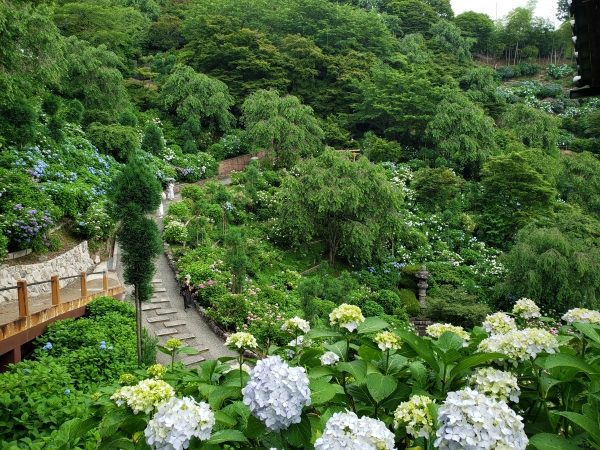Yoshiminedera Temple: The hydrangeas in the clouds above Kyoto

Kyoto (京都) has three temples that are particularly famous for hydrangeas during the rainy season in Japan—Mimurotoji Temple (三室戸寺 Mimuroto-ji) in Uji (宇治), Yokokuji Temple (楊谷寺 Yōkoku-ji) with its floating hydrangea displays, and Yoshiminedera Temple (吉峯寺 Yoshimine-dera) established on Kyoto’s western mountainside. When the colourful flowers start to bloom, these temples see a lot of visitors. Mimurotoji is often considered the most ideal location but this is mostly because of its ease of accessibility near Uji Station (宇治駅 Uji-eki). However, the two remaining temples are actually a more ideal environment for hydrangeas as they are built on the mountainside.
Kyoto’s geological location is unique in that it is surrounded by mountains, creating a basin where rainwater can flow down, creating the ideal environment for hydrangeas to bloom. Yoshiminedera in particular has steep slopes and long stairs that meander to the top. The altitude reaches over the low-hanging clouds during the rainy season and nourishes a plethora of hydrangeas, making these the lushest in all of Kyoto.

(Image credit: Ilse Montald)
This Buddhist temple was established in 1029 by a monk named Gensan from Tottori Prefecture. The main building is dedicated to the goddess of mercy, Kannon (観音), and in 1034 the emperor gave the temple an imperial title and the protection and sponsorships that come with. Since that day, Yoshiminedera had become part of the Kansai-area of the Saigoku Kannon Pilgrimage (西国三十三所 Saigoku Sanjūsan-sho). Modern pilgrims arrive by car or by bus, but it is amazing to think that a community of monks actually lived so far and high from civilisation with frequent visits from pilgrims. The principal relic of the temple is the statue of Senju Kannon (千手観音), or “Thousand-handed Kannon”, located in the main building Kannon-do. A more modern landmark is 54m tall pine tree lovingly called Yuryu no Matsu (遊龍の松 Playing Dragon’s Pine)


(Image credit: Ilse Montald)
The walk to the top of the temple precinct takes about 40 minutes on steep stairs surrounded by greenery. Looking down, you have a magnificent view of Kyoto City (京都市 Kyoto-shi) covered by thin clouds. Truly a sight you can only experience during the rainy season. Tufts of hydrangeas colour the sides of the ancient stone paths, leading you to an observation area and a hidden waterfall that is said to grant eternal life.


(Image credit: Ilse Montald)
After your visit to the temples, the main garden awaits. The unique thing about this garden is that it is actually not as carefully tended and meticulously pruned as most hydrangea gardens. The natural nutrients from the soil and the free-range growing style actually aid in creating an abundance of colours. If you look closer at the petals, you can actually see that the garden has a variety of hydrangea types mixed together to create a pastel rainbow against the mountainside. Should you find yourself in Kyoto during the rainy season, I highly recommend going to Yoshiminedera. The feeling of stepping into a different world will be a memory to treasure forever.
Yoshiminedera Temple (吉峰寺)
Address: 1372 Oharano Oshio-cho, Nishikyo-ku, Kyoto-shi, Kyoto 610-1133
Access: Take the Hankyu Bus 66 to Yoshiminedera Bus Stop from either JR Mukomachi (向日町駅 Mukōmachi-eki) or Hankyu Higashimuko Station (阪急東向日駅 Hankyū Higashi-Mukō-eki). The ride takes about 30 minutes.
Opening hours: 8am–5pm
Admission fee: ¥500
Tel: +81 75-331-0020
Header image credit: Ilse Montald





